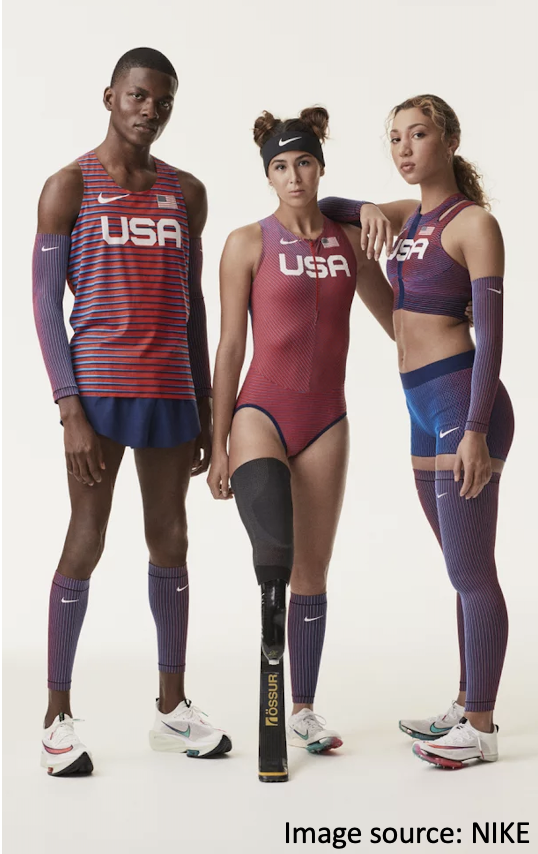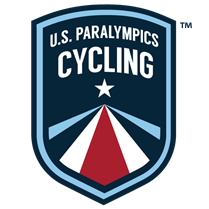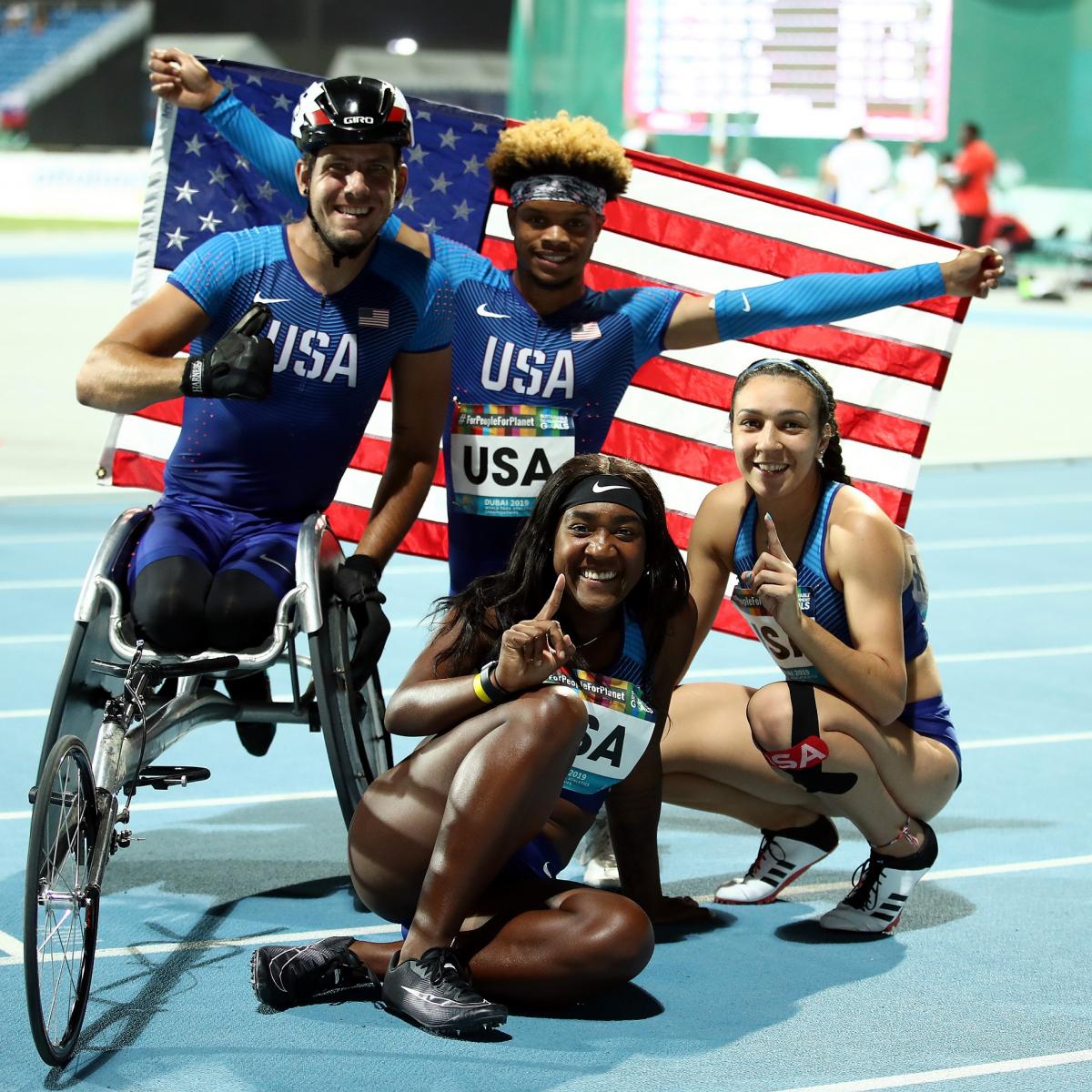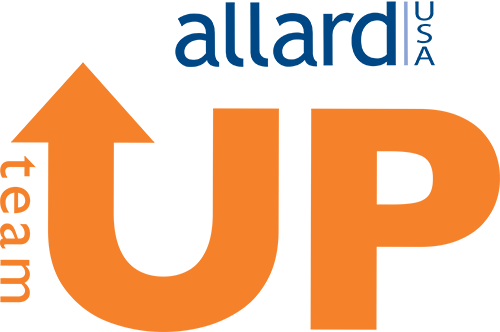
Wow, what an incredible two weeks of Olympic competition we just witnessed. Now get ready to kick it up a notch as the excitement builds for the Paralympics! The official Opening Ceremony begins at 8pm Tokyo time on August 24thwhere we anticipate the start of another spectacular show. All of us at Get Back UP Today can hardly wait for the thousands of elite athletes to take the world stage, competing in 539 events across 22 sports.
We are especially excited that two of our very own TeamUP Co-Captains, Jill Walsh and Jamie Whitmore, will be returning to the Paralympics after their medal-winning performances at the 2016 Rio Games. To be sure, attaining the status of an Olympian or Paralympian is an extraordinary achievement for any athlete, but to represent your country over multiple Games is a rare feat indeed so we cannot be prouder of these 2 remarkable women!

As we’ve been following and reporting on the Paralympic trials leading up to these Tokyo games, we’ve received many questions—and discovered many misconceptions—about the Paralympics. We decided this was the perfect opportunity to offer “everything you need to know” about the history and behind-the-scenes workings of the Paralympic organization as well as a guide for how to follow this year’s competition. We hope you will find these helpful!
Paralympics Origin and Historical Facts
- Sports for impaired athletes have been in existence for over 100 years, but it wasn’t until after World War II that these were widely introduced.
- The original purpose of these sports was to assist in the rehabilitation of veterans and civilians injured during the war.
- The first “adaptive games” took place on July 29, 1948, occurring at the same time as the Olympics, and were called the Stoke Mandeville Games. These games were organized by Dr. Ludwig Guttman, with the inaugural event including 16 physically impaired servicemen and women who competed in archery.
- The Stoke Mandeville games later became the Paralympic Games, with the first events taking place in Rome in 1960 with 400 athletes from 23 countries. Ever since, these games are held every four years in conjunction with the Olympics.
- Over many decades, several organizations sought to include athletes with disabilities who could not affiliate with the Stoke Mandeville Games; the goal was to embrace all impairments. Eventually, in September of 1989, the International Paralympic Committee was founded as an international governing body of the global Paralympic Movement.
- The first Winter Paralympics were held in Sweden in 1976 and have occurred every 4 years since.
- Beginning with the Seoul Summer Games of 1988, and the Albertville, France Winter Games of 1992, both the Olympics and Paralympics have taken place at the same venues thanks to an agreement between the IOC (International Olympic Committee) and the IPC (International Paralympic Committee).
Paralympic Fundamentals
- The name “Paralympics” comes from combining the Greek preposition, “para” (beside or alongside) with the word “Olympics”. This means that the Paralympics are parallel to the Olympics
- The Paralympics are the second-biggest sporting event in the world
- The Paralympics have a separate logo from that of the Olympics. The 5-color “Olympic Rings” logo was designed by Coubetin in 1913 as a symbol of international unity. The rings symbolize the 5 continents, and their colors represent the colors of the flags of all competing countries. The current Paralympic logo was designed by the agency Scholz and Friends as a modernization of the emblem originally adopted in 1992. This logo is comprised of tri-colored crescents called “agitos” (Latin for “I move”) encircling a single point against a white field. The agitos’ shape symbolizes movement while their colors—red, green and blue—represent the most widely-used colors of national flags around the world

- The Paralympic motto is “Spirit in Motion”, and in 2019 a new “branding narrative” was announced—Change Starts With Sport—to convey the transformative power of the Paralympic Movement
- There are four core values at the heart of the Paralympic Movement: courage, determination, inspiration and equality. Each athlete strives to embody these values as they work to transform attitudes, break down barriers and empower generations of people around the world.
- All Paralympic competitors must fall into one of 10 impairment groups, and they undergo strict “athlete evaluations” to be grouped into impairment classifications to ensure fairness. The IPC compares this process to the grouping of athletes by gender, weight, or age
- If you have earned a spot to represent your country in competition at the official International Olympic Games, you are an Olympian. If you have earned a spot to represent your country in competition at the official International Paralympic Games, you are a Paralympian
- If an athlete has a disability but has not represented their country at the Paralympics they are not a Paralympian, they are an athlete with a disability or an adaptive athlete
- More than 34 athletes have competed in both the Paralympics and the Olympics, thus they are both Paralympians and Olympians.
Paralympian Classification System
- The IPC recognizes the following 10 impairment types when considering athletes’ eligibility: impaired muscle power (which can result from a condition such as spina bifida or multiple sclerosis), impaired passive range of movement, limb deficiency (which can result from congenital conditions or amputation), leg length difference, short stature, hypertonia (an increase in muscle tension caused by damage to the central nervous system), ataxia (uncoordinated movement caused by damage to the central nervous system), athetosis (continual slow involuntary movements), vision impairment and intellectual impairment
- Para-athletes’ various impairments result in a competitive disadvantage; thus, a system has been put in place to minimize the impact of these impairments on performance to ensure that “the success of an athlete is determined by skill, fitness, power, endurance, tactical ability and mental focus. This system is called classification.”
- Classification systems differ by sport and are developed by the International Federations (IF) governing the sport
- The IF determines which eligible impairments are accepted for each sport. For example, Goalball is only open to athletes with a visual impairment whereas swimming is open to athletes with any of the 10 eligible impairments
- The IF determines how severe an impairment must be to be considered eligible. For any athlete who fails to meet “The Minimum Impact Criteria”, the IF recognizes the genuine impairment but does not allow for that athlete to compete under the IF Sport Rules
- Within each sport, every attempt is made to minimize the disadvantage of the athletes’ impairments by grouping athletes with similar physical impairments and/or similar degrees of impairment. For example, here is the breakdown for Paracycling events according to Olympics.com:

Athletes compete in C (cycling), H (handcycling), T (tricycle) and B (tandem) classes, depending on their impairment. C class is for athletes with limb deficiency, impaired muscle power or range of motion and impairments affecting co-ordination, such as uncoordinated movements and involuntary movements and is subdivided into classes C1, C2, C3, C4 and C5 according to the severity of impairment. H class is for handcycle athletes with impairments such as amputation or paralysis of the legs or motor function impairments and is subdivided into classes H1, H2, H3, H4 and H5. T class is for athletes who compete on racing trikes (tricycles) and is subdivided into classes T1 and T2. T class athletes have impairments such as a lack of balance and/or restriction in pedaling due to muscle tension, uncoordinated movements or involuntary movement. B class is for athletes with vision impairments competing on a tandem bike with a sighted pilot. B1, B2 and B3 athletes compete in one event.
- Classifying athletes with impairments is a complicated and ongoing process. Depending on the type and severity of the impairment an athlete might undergo evaluation several times throughout his or her career. Decisions made by classification panels can be challenged under specific conditions
- Read here for complete guide to Paralympic Classification
Dispelling Common Myths about the Paralympics
Following the 2016 Rio Paralympics, Team USA addressed the most common misconceptions they faced, sharing “Let us debunk 10 common myths in the United States about the Paralympic Movement, with insight from wheelchair rugby’s Chuck Aoki, cycling’s Jamie Whitmore and alpine skiing’s Danelle Umstead.” See below for what they had to say:
Myth: The Paralympic Games and the Special Olympics are one in the same.
This is arguably the biggest misconception about the Paralympics in the United States, one of the few countries where more people have heard more about the latter than the former. Aoki put the difference best, saying: “The Special Olympics are framed as more of an inclusive event for everyone with cognitive disabilities, as opposed to a highly competitive event for athletes with mostly physical and visual disabilities.”
But while the confusion may be a tough pill to swallow for many Paralympians, they are also courteous enough to not be critical. “You never want to offend someone that’s asking and truly doesn’t know,” Whitmore said. “They’re not trying to be disrespectful, so I’m very careful about choosing my words on that question.”
Myth: The Paralympics are the same as the Paraolympics, Para Olympics and Pair Olympics.
There’s only one way to spell Paralympics. The other words do not exist.
Myth: The Paralympics are named after people with paraplegia.
The word “Paralympic” derives from the Greek preposition “para,” which means beside or alongside, as well as the word “Olympic.” Its meaning is that the Paralympic Games are parallel to the Olympic Games and illustrates how the two movements exist side-by-side.
Myth: To be a Paralympian, you must have a visible disability.
A lot of people get confused when they see a Paralympian without a clearly identifiable disability, such as a prosthetic leg or a wheelchair. Whitmore, for example, has both her legs, but she has a paralysis of one leg and walks with a limp. This leads many people to assume she just has a temporary injury. Umstead, meanwhile, skis with a guide, but in everyday life it’s not readily apparent she’s visually impaired. “People are always asking me, ‘Wait, you’re blind?’ I don’t get it. What does blind look like? What should I be doing, wearing sunglasses?”
Myth: All of the classifications are confusing, and it’s too complicated to understand what’s going on in Paralympic sport.
Paralympic athletes are placed in categories for competition based on the severity of their impairment — a process similar to grouping athletes by age, gender or weight. The purpose of classification is to minimize the impact of impairment on sport performance, and thus classification is specific to each individual sport and discipline.
“It just comes down to education,” Whitmore said of understanding the classification system. “Anyone who can be educated on why somebody is disabled can learn it.”
Myth: You don’t have to be an elite athlete to be a Paralympian.
As previously mentioned, the Paralympic Games parallel the Olympic Games, with athletes having to qualify and always prove themselves as the best of the best. Thus, by no means is every person with a disability who plays a sport a Paralympian.
“That’s kind of absurd, quite frankly,” Aoki said. “It’s a little bit of an insult to us.”
Aoki is justified in saying that, as Paralympians, from the most severely to the least severely impaired, train every day, just as hard as Olympians. And you certainly don’t go around calling every able-bodied person who plays a sport an Olympian, do you?
Myth: The goal of every Paralympian is to inspire the world.
This is potentially the most controversial myth within the Paralympic Movement. A lot of Paralympians are bothered by the word “inspiring,” while others love to adhere to it.
Aoki put everything into perspective nicely:
“The goal of the Paralympics and the Paralympic Movement is to inspire the world,” he said. “The goal of Paralympians is to be the best at what we do — to be the best athletes we can be by representing our country at the highest level. And if inspiring people comes along with that, then sure, that’s great. I really want kids with disabilities to not have to say, ‘I want to be like LeBron James or I want to be like Russell Wilson.’ No. I want to hear them say, ‘I want to be like Tatyana McFadden or I want to be like Steve Serio.’”
Most Paralympians can agree that if they’re inspiring someone, then they want to be inspiring the right person for the right reasons. They want to inspire the next generation of athletes, to inspire people with a disability to get involved with sport and to inspire people by sharing stories they can learn or grow from.
Myth: A Paralympian and Olympian are the same thing.
While Paralympians and Olympians are all elite athletes who train at the same level and compete in the same sports in the same venues, there is a slight difference in that Paralympians have a disability and Olympians do not. The Paralympic Games are also overseen by the International Paralympic Committee (IPC), a governing body separate from the International Olympic Committee (IOC), although the two have a longstanding partnership.
Aoki said he embraces that slight difference, as that’s what makes Paralympians so unique. He pushes back when someone accidentally refers to him as an Olympian in order to promote the Paralympic values and brand instead. Without athletes like Aoki, the Paralympic Movement wouldn’t grow as rapidly as it has been.
Myth: Every Paralympian is a military veteran.
Whitmore said people often assume that because she’s a Paralympian, she’s also a military veteran. But that’s not the case. While a sizeable number of U.S. Paralympians have military ties, the majority of Paralympic athletes were either born with their disability or came into it later in their life because of an accident or development.
Myth: If you don’t know how to refer to an athlete with a disability, you should just not talk about them at all.
No Paralympian has the same exact disability or degree of disability. Many Paralympians of both backgrounds, though, prefer to have someone ask questions rather than stay silent or make assumptions. Their disability is a part of who they are.
Many Paralympians even have a sense of humor about their disability and enjoy lightening up conversations that might otherwise be awkward.
“I like to laugh and I like to make fun of myself, so I think it’s funny when people don’t know to say something properly,” Umstead said. “I make it easy for them by cracking a joke and making them comfortable. I think we should all talk to each other whether we’re disabled or not. Don’t be scared to talk to each other and ask questions. How else would we know or learn?”
Stuart Lieberman covered Paralympic sports for three years at the International Paralympic Committee, including at the London 2012 and Sochi 2014 Games. He is a freelance contributor to TeamUSA.org on behalf of Red Line Editorial, Inc.
 ⒸGetty Images
ⒸGetty Images
So there you have it, everything you need to know about the Paralympic Games! Next up is Part 2 of our guide, Fun Facts, Fan Favorites and How to Follow the Tokyo 2020 Paralympics so please stay tuned!
Sources for the information in this blog include: TeamUSA.org, Olympics.com, aarp.org, nestle-cereals.com and Paralympic.org.

Recent Comments